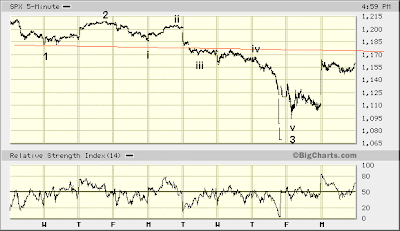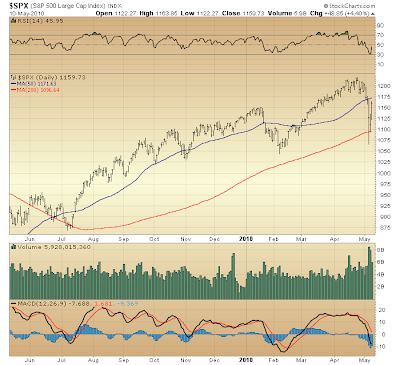Is Euro-TARP the "game changer" Cramer claims?
Yes, it is. Trouble is the Shemp monkey is looking for a reaction in the wrong direction. His mistake is supposing seven hundred billion euros is the same as one trillion U.S. dollars. It's not.
Truth is there is but one reserve currency possessing the luxury of stuffing the globe chock full of claims, able to withstand sagging support so long as it can prevent the floor from collapsing beneath it. Such capacity the euro does not possess in the least, however.
Thus, the minute Europe's central banks begin monetizing bad debts held by European banks say goodbye to the carry trade financed virtually at 0%. Not only does Euro-TARP reveal the global financial system remains capital-starved and bankrupt, but by its necessary existence (and its likelihood of being tapped) a new vulnerability is opened to hot money flows whose critically essential direction into the euro (if collapse is to be forestalled) seems likely to pressure yields significantly higher.
This is a dynamic even the common monetarist monkey should be able to fathom at this point. Apparently not the Shempster, though.
Per the fact that, market moves like today's find precedent only in September and October 2008? Meaningless to CNBC's poster child shamelessly endorsing a return to 1923 Wiemar Germany!
Not so here, though. If alarm bells weren't sounding in your mind when, this morning, we learned the pre-market futures bid was rivaled only by that seen in September and October 2008, then may I suggest fewer bananas and a fragrant bouquet of carnations?
The point is that, much like 2008, there is good reason to fear a further, strong dose of selling ... although in portions fitting this early moment in the stock market's anticipated collapse.

No change to the Elliott wave count presented Friday. Indeed, today's lift into the range of "the fourth wave of one lesser degree" was rather anticipated via the green line drawn on Friday's S&P 500 5-minute chart.
(The red line of resistance drawn above appears a bit more compelling than that green line connecting fourth wave tops, though. Its intersecting the gap below wave 1 during formation of wave iii of 3 appears particularly significant.)
So, seeing that wave iv of 3 unfolded in about twice the time as wave ii of 3, wave 4 (of five [initial] waves down from top) might be expected to unfold over much of this week's trading, being that wave 2 lasted a couple days.
Admittedly a guess, but if correct, then chances are, too, wave 4 is trading at the upper end of its eventual range.

Considering the size of today's move, there really was not any remarkable improvement in the market's underlying technical condition. You see this above via relative strength and momentum (both of which remain on the sell-side of their respective ranges, with the former acting quite like it did to conclude the week Lehman Brothers failed) ... as well as among other various measures periodically analyzed here. What technical improvement occurred today merely was fitting such deterioration as was registered last week.
The technical state of things apparently warns of further weakness following a brief period correcting last week's losses (that is once certain, still weak readings improve a bit more). This condition remains in keeping with the outlook put forward Friday, wherein the S&P 500's decisive move below its 200-day moving average is seen ending the index's initial fall from last month's top.
Per this concluding move lower, the lesson of wave v of 3 raises the possibility that, a rather severe decline could be in store — a possibility whose likelihood is heightened by today's sharp, upside reaction. Indeed, a setback reaching even last July's levels would be fitting both last week's throttling, as well as the market's anticipated collapse to come...

* * * * *
© The Risk Averse Alert — Advocating a patient, disciplined approach to stock market investing. Overriding objective is limiting financial risk. Minimizing investment capital loss is a priority.
Analysis centers on the stock market's path of least resistance. Long-term, this drives a simple strategy for safely investing a 401(k) for maximum profit. Intermediate-term, investing with stock index tracking-ETFs (both their long and short varieties) is advanced. Short-term, stock index options occasionally offer extraordinary profit opportunities when the stock market is moving along its projected path.
Nothing is set in stone. Nor is the stock market's path of least resistance always known. More often than not, there are no stock index option positions recommended.
 There's an easy way to boost your investment discipline...
There's an easy way to boost your investment discipline...Get Real-Time Trade Notification!



















